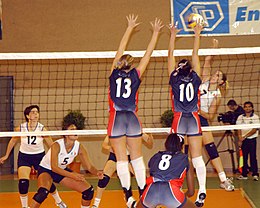Volleyball Game Information In Marathi Language

General Information on the sport of volleyball. Volleyball - General Information. Characteristics of the Game. History of Volleyball. Volleyball Centennial (1895-1995).
• • • • 5-5-3b(12): Outlines mechanics for the second referee to sound a warning whistle at 45 seconds or any other time when both teams take the court ready to play before the audio signal (horn) is sounded at 60 seconds. Clarifies all time-outs are officially ended with the audio signal (horn). Rationale: The defining end of a time-out shall be the horn and the warning of the impending end of the time-out is the second referee’s whistle at 45 seconds or at any other time when both teams take the court ready to play before the audio horn is sounded at 60 seconds. 5-4-3c(17): On a time-out, the first referee shall whistle the warning if the second referee is still checking the scoresheet. Rationale: A procedure is needed for the sounding of the warning whistle should the second referee still be involved with checking the scoresheet. 5-8-3a: Outlines the new procedures for the timer to give the audio signal (horn) only to officially end a time-out and no longer for the warning at 45 seconds into the time-out.
Rationale: Clarifies that the audio signal (horn) shall only be sounded to indicate the official end of a time-out. 9-8-2 New: A replay, is considered, to be a part of a single play action. Therefore, once a replay has been called, by the first referee, no requests, e.g., time-out, service order, lineup, substitution, libero replacement, etc., may be recognized until after the rally is completed.
Rationale: A replay is a single action to repeat the start and completion of a rally that was interrupted under Rule 9-8-1. Clarifies when resuming play, all circumstances should be the same and no requests shall be recognized for, e.g. Time-out, service order, lineup, substitution, libero replacement etc. Officials Signals: Omit the illegal substitution signal (Signal # 20) as the penalty is Unnecessary Delay if attempting to enter the set and illegal alignment if observed in the set. Rationale: The penalty for illegal substitution is 'unnecessary delay--administrative yellow or red card;' there is no longer a need to have two penalty signals, illegal substitution and unnecessary delay.
2017-18 VOLLEYBALL MAJOR EDITORIAL CHANGES 2-1-5: Clarifies the language regarding the attack line shall be solid and one clearly visible color. 5-2-1b: Clarifies when the second referee will indicate both the nature of the fault and the number of the player committing the net fault. 2017-2018 Volleyball Editorial Changes 4-1 Penalty 3, 4-2 Penalty 2, 10-3-3, 11-2 Penalties 1 and 2, Sample Sets 2017-18 Volleyball Points of Emphasis 1. Conduct and Privileges of Assistant Coaches 2. Court Boundary Lines and Attack Lines 3.
Second Referee-Handling of Request for Third Time-Out 4. Letters of Authorization 5. Mechanics of Signals and Communication.

This was How Volleyball was Introduced – Facts and Information About the Game The game of volleyball, originally called “mintonette,” was invented in 1895 by William G. Morgan after the invention of basketball only four years before. Download anna maria pinter teaching young language learners pdf. Morgan, a graduate of the Springfield College of the YMCA, designed the game to be a combination of basketball, baseball, tennis, and handball. The first volleyball net, borrowed from tennis, was only 6’6″ high (though you need to remember that the average American was shorter in the nineteenth century). The offensive style of setting and spiking was first demonstrated in the Philippines in 1916.